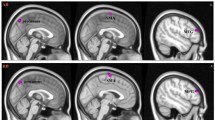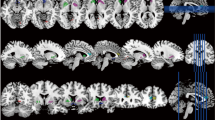Abstract
The coupling between resting-state cerebral blood flow (CBF) and blood oxygenation level-dependent (BOLD) signals reflects the mechanism of neurovascular coupling (NVC), which have not been illustrated in attention-deficit/hyperactivity disorder (ADHD). Fifty ADHD and 42 age- and gender-matched typically developing controls (TDs) were enrolled. The NVC imaging metrics were investigated by exploring the Pearson correlation coefficients between CBF and BOLD-derived quantitative maps (ALFF, fALFF, DCP maps). Three types of NVC metrics (CBF-ALFF, CBF-fALFF, CBF-DCP coupling) were compared between ADHD and TDs group, and the inner association between altered NVC metrics and clinical variables in ADHD group was further analyzed. Compared to TDs, ADHD showed significantly reduced whole-brain CBF-ALFF coupling (P < 0.001). Among regional level (all PFDR < 0.05), ADHD showed significantly lower CBF-ALFF coupling in bilateral thalamus, default-mode network (DMN) involving left anterior cingulate (ACG.L) and right parahippocampal gyrus (PHG.R), execution control network (ECN) involving right middle orbital frontal gyrus (ORBmid.R) and right inferior frontal triangular gyrus (IFGtriang.R), and increased CBF-ALFF coupling in attention network (AN)-related left superior temporal gyrus (STG.L) and somatosensory network (SSN))-related left rolandic operculum (ROL.L). Furthermore, increased CBF-fALFF coupling was found in the visual network (VN)-related left cuneus and negatively correlated with the concentration index of ADHD (R = − 0.299, PFDR = 0.035). Abnormal regional NVC metrics were at widespread neural networks in ADHD, mainly involved in DMN, ECN, SSN, AN, VN and bilateral thalamus. Notably, this study reinforced the insights into the neural basis and pathophysiological mechanism underlying ADHD.





Similar content being viewed by others
Data availability
Data generated or analyzed during the study are available from the corresponding author by request.
Abbreviations
- ADHD:
-
Attention-deficit/hyperactivity disorder
- TD:
-
Typically developing
- NVC:
-
Neurovascular coupling
- BOLD:
-
Blood oxygenation level dependent
- ASL:
-
Arterial spin labeling
- CBF:
-
Cerebral blood flow
- ALFF:
-
Amplitude of low-frequency fluctuation
- fALFF:
-
Fractional amplitude of low-frequency fluctuation
- DC:
-
Degree centrality
- DMN:
-
Default-mode network
- AN:
-
Attention network
- SN:
-
Salience network
- SSN:
-
Somatosensory network
- VN:
-
Visual network
References
Posner J, Polanczyk GV, Sonuga-Barke E (2020) Attention-deficit hyperactivity disorder. Lancet 395(10222):450–462
Zang YF et al (2007) Altered baseline brain activity in children with ADHD revealed by resting-state functional MRI. Brain Dev 29(2):83–91
Li F et al (2014) Intrinsic brain abnormalities in attention deficit hyperactivity disorder: a resting-state functional MR imaging study. Radiology 272(2):514–523
Cortese S et al (2021) Systematic review and meta-analysis: resting-state functional magnetic resonance imaging studies of attention-deficit/hyperactivity disorder. J Am Acad Child Adolesc Psychiatry 60(1):61–75
Pereira-Sanchez V, Castellanos FX (2021) Neuroimaging in attention-deficit/hyperactivity disorder. Curr Opin Psychiatry 34(2):105–111
Wang L et al (2009) Altered small-world brain functional networks in children with attention-deficit/hyperactivity disorder. Hum Brain Mapp 30(2):638–649
Cao M et al (2014) Imaging functional and structural brain connectomics in attention-deficit/hyperactivity disorder. Mol Neurobiol 50(3):1111–1123
Yin WY et al (2022) Altered neural flexibility in children with attention-deficit/hyperactivity disorder. Mol Psychiatry 27(11):4673–4679
Shappell HM et al (2021) Children with attention-deficit/hyperactivity disorder spend more time in hyperconnected network states and less time in segregated network states as revealed by dynamic connectivity analysis. Neuroimage 229:117753
Shang CY et al (2016) Differential effects of methylphenidate and atomoxetine on intrinsic brain activity in children with attention deficit hyperactivity disorder. Psychol Med 46(15):3173–3185
Jiang K et al (2019) Functional network connectivity changes in children with attention-deficit hyperactivity disorder: a resting-state fMRI study. Int J Dev Neurosci 78:1–6
Vaishnavi SN et al (2010) Regional aerobic glycolysis in the human brain. Proc Natl Acad Sci U S A 107(41):17757–17762
Schrantee A et al (2017) The age-dependent effects of a single-dose methylphenidate challenge on cerebral perfusion in patients with attention-deficit/hyperactivity disorder. Neuroimage Clin 13:123–129
O’Gorman RL et al (2008) Increased cerebral perfusion in adult attention deficit hyperactivity disorder is normalised by stimulant treatment: a non-invasive MRI pilot study. Neuroimage 42(1):36–41
Iadecola C (2017) The neurovascular unit coming of age: a journey through neurovascular coupling in health and disease. Neuron 96(1):17–42
Liang X et al (2013) Coupling of functional connectivity and regional cerebral blood flow reveals a physiological basis for network hubs of the human brain. Proc Natl Acad Sci U S A 110(5):1929–1934
Zhu JJ et al (2017) altered coupling between resting-state cerebral blood flow and functional connectivity in schizophrenia. Schizophr Bull 43(6):1363–1374
Tarantini S et al (2017) Impaired neurovascular coupling in aging and Alzheimer’s disease: contribution of astrocyte dysfunction and endothelial impairment to cognitive decline. Exp Gerontol 94:52–58
He Z et al (2019) Altered resting-state cerebral blood flow and functional connectivity of striatum in bipolar disorder and major depressive disorder. Prog Neuropsychopharmacol Biol Psychiatry 90:177–185
Callahan BL et al (2021) Contribution of vascular risk factors to the relationship between ADHD symptoms and cognition in adults and seniors. Sci Rep. https://doi.org/10.1038/s41598-021-03782-y
Liu L et al (2018) Deficiency of sustained attention in ADHD and its potential genetic contributor MAOA. J Atten Disord 22(9):878–885
Farre-Colomes A et al (2021) Common and distinct neural connectivity in attention-deficit/hyperactivity disorder and alcohol use disorder studied using resting-state functional magnetic resonance imaging. Alcohol Clin Exp Res 45(5):948–960
Wang LF et al (2014) Overlapping and segregated resting-state functional connectivity in patients with major depressive disorder with and without childhood neglect. Hum Brain Mapp 35(4):1154–1166
Liu F et al (2015) Disrupted cortical hubs in functional brain networks in social anxiety disorder. Clin Neurophysiol 126(9):1711–1716
Scholvinck ML et al (2010) Neural basis of global resting-state fMRI activity. Proc Natl Acad Sci U S A 107(22):10238–10243
Zou QH et al (2008) An improved approach to detection of amplitude of low-frequency fluctuation (ALFF) for resting-state fMRI: fractional ALFF. J Neurosci Methods 172(1):137–141
Tzourio-Mazoyer N et al (2002) Automated anatomical labeling of activations in SPM using a macroscopic anatomical parcellation of the MNI MRI single-subject brain. Neuroimage 15(1):273–289
Kaplan L, Chow BW, Gu C (2020) Neuronal regulation of the blood-brain barrier and neurovascular coupling. Nat Rev Neurosci 21(8):416–432
Baller EB et al (2022) Developmental coupling of cerebral blood flow and fMRI fluctuations in youth. Cell Rep 38(13):110576
Mauri M et al (2018) Light up ADHD: I. Cortical hemodynamic responses measured by functional Near Infrared Spectroscopy (fNIRS) Special Section on “Translational and Neuroscience Studies in Affective Disorders” Section Editor, Maria Nobile MD, PhD. This Section of JAD focuses on the relevance of translational and neuroscience studies in providing a better understanding of the neural basis of affective disorders. The main aim is to briefly summarise relevant research findings in clinical neuroscience with particular regards to specific innovative topics in mood and anxiety disorders. J Affect Disord 234:358–364
von Rhein D et al (2017) Network-level assessment of reward-related activation in patients with ADHD and healthy individuals. Hum Brain Mapp 38(5):2359–2369
Zhu Y, Jiang X, Ji W (2018) The mechanism of Cortico-Striato-Thalamo-Cortical neurocircuitry in response inhibition and emotional responding in attention deficit hyperactivity disorder with comorbid disruptive behavior disorder. Neurosci Bull 34(3):566–572
Wu J et al (2012) Role of dopamine receptors in ADHD: a systematic meta-analysis. Mol Neurobiol 45(3):605–620
Wang K, Li K, Niu X (2021) Altered functional connectivity in a triple-network model in Autism with co-occurring attention deficit hyperactivity disorder. Front Psychiatry 12:736755
Gao Y et al (2019) Impairments of large-scale functional networks in attention-deficit/hyperactivity disorder: a meta-analysis of resting-state functional connectivity. Psychol Med 49(15):2475–2485
Shang CY, Lin HY, Gau SS (2021) The norepinephrine transporter gene modulates intrinsic brain activity, visual memory, and visual attention in children with attention-deficit/hyperactivity disorder. Mol Psychiatry 26(8):4026–4035
Alonso Bde C et al (2014) A multi-methodological MR resting state network analysis to assess the changes in brain physiology of children with ADHD. PLoS ONE 9(6):e99119
He X et al (2021) The morphometry of left cuneus mediating the genetic regulation on working memory. Hum Brain Mapp 42(11):3470–3480
Acknowledgements
This work was supported by the Natural Science Fund Youth Science Fund Project of China [grant number 82001439], the Natural Science Fund Project of Guangdong Province [grant numbers 2022A1515011910] and the Guangdong Basic and Applied Basic Research Foundation, China (No.2020A1515011436). We would like to thank the participants and their families and the staff at the MRI at the First Affiliated Hospital of Sun Yat-sen University for all their help and support.
Funding
This work was supported by the Natural Science Fund Youth Science Fund Project of China [grant numbers 82001439], the Natural Science Fund Project of Guangdong Province [grant numbers 2022A1515 011910], and the Guangdong Basic and Applied Basic Research Foundation, China (No.2020A1515011436).
Author information
Authors and Affiliations
Contributions
Shu Su, Yingqian Chen, Jing Zhao and Zhiyun Yang wrote the main manuscript text. Shu Su, Yingqian Chen, Yan Dai, Long Qian, Wei Cui and Liping Lin prepared figures 1-5. Qin Zhou, Zi Yan, Hongyu Zhang and Meina Liu collected the imaging and clinical data. All authors reviewed the manuscript.
Corresponding authors
Ethics declarations
Conflict of interest
The authors of this manuscript declare no relationships with any companies whose products or services may be related to the subject matter of the article.
Ethical approval and consent to participate
This study was approved by the institutional review board of our institution (No. [2019]328). Written informed consent was obtained from the guardians of all the subjects and their guardians in this study.
Supplementary Information
Below is the link to the electronic supplementary material.
Rights and permissions
Springer Nature or its licensor (e.g. a society or other partner) holds exclusive rights to this article under a publishing agreement with the author(s) or other rightsholder(s); author self-archiving of the accepted manuscript version of this article is solely governed by the terms of such publishing agreement and applicable law.
About this article
Cite this article
Su, S., Zhao, J., Dai, Y. et al. Altered neurovascular coupling in the children with attention-deficit/hyperactivity disorder: a comprehensive fMRI analysis. Eur Child Adolesc Psychiatry 33, 1081–1091 (2024). https://doi.org/10.1007/s00787-023-02238-0
Received:
Accepted:
Published:
Issue Date:
DOI: https://doi.org/10.1007/s00787-023-02238-0




